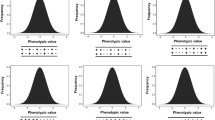Abstract
Haldane (1937) showed that the reduction of equilibrium mean fitness in an infinite population due to recurrent deleterious mutations depends only on the mutation rate but not on the harmfulness of mutants. His analysis, as well as more recent ones (cf. Crow 1970), ignored back mutation. The purpose of the present paper is to extend these results to arbitrary mutation patterns among alleles and to quantitative genetic traits. We derive first-order approximations for the equilibrium mean fitness (and the mutation load) and determine the order of the error term. For a metric trait under mutation-stabilizing-selection balance our result differs qualitatively from that of Crow and Kimura (1964), whose analysis is based on a Gaussian assumption. Our general approach also yields a mathematical proof that the variance under the usual mutation-stabilizing-selection model is, to first order, µ/s (the house-of-cards approximation) as µ/s tends to zero. This holds for arbitrary mutant distributions and does not require that the population mean coincide with the optimum. We show how the mutant distribution determines the order of the error term, and thus the accuracy of the house-of-cards approximation. Upper and lower bounds to the equilibrium variance are derived that deviate only to second order as µ/s tends to zero. The multilocus case is treated under the assumption of global linkage equilibrium.
Similar content being viewed by others
References
Barton, N.: The maintenance of polygenic variation through a balance between mutation and stabilizing selection. Genet. Res. Camb. 47, 209–216 (1986)
Bulmer, M. G.: The genetic variability of polygenic characters under optimising selection, mutation and drift. Genet. Res. 19, 17–25 (1972)
Bürger, R.: On the maintenance of genetic variation: Global analysis of Kimura's continuum-ofalleles model. J. Math. Biol. 24, 341–351 (1986)
Bürger, R.: Perturbations of positive semigroups and applications to population genetics. Math. Z. 197, 259–272 (1988)
Bürger, R.: Linkage and the maintenance of heritable variation by mutation-selection balance. Genetics 121, 175–184 (1989)
Bürger, R.: Moments, cumulants, and polygenic dynamics. J. Math. Biol. 30, 199–213 (1991)
Bürger, R.: Predictions for the dynamics of a polygenic character under directional selection. J. Theor. Biol. 162, 487–513 (1993)
Bürger, R., Bomze, I. M.: Mutation-selection balance and a perturbation problem on the space of measures. SIAM J. Math. Anal (submitted)
Crow, J. F.: Genetic loads and the coast.of natural selection. In: Kojima, K. (ed.), Mathematical Topics in Population Genetics, pp. 128–177. Berlin Heidelberg New York: Springer 1970
Crow, J. F., Kimura, M.: The theory of genetic loads. In: Proc XI Int. Congr. Genetics, vol. 2, pp. 495–505. Oxford: Pergamon Press 1964
Crow, J. F., Kimura, M.: An Introduction to Population Genetics Theory. New York: Harper and Row 1970
Fleming, W. H.: Equilibrium distributions of continuous polygenic traits. SIAM J. Appl. Math. 36, 148–168 (1979)
Fraser, G. R., Mayo, O.: Genetic load in man. Humangenetik. 23, 83–110 (1974)
Gröbner, W., Hofreiter, N.: Integraltafel. Zweiter Teil. Berlin Heidelberg New York: Springer 1975
Haldane, J. B. S.: The effect of variation on fitness. Am. Nat. 71, 337–349 (1937)
Haldane, J. B. S.: The cost of natural selection. J. Genet. 55, 511–524 (1957)
Hofbauer, J.: The selection mutation equation. J. Math. Biol. 23, 41–53 (1985)
Hofbauer, J., Sigmund, K.: The Theorie of Evolution and Dynamical Systems. Cambridge: Cambridge University Press 1988
Keightley, P. D., Hill, W. G.: Quantitative genetic variability maintained by mutation-stabilizing selection balance in finite populations. Genet. Res. Camb. 52, 33–43 (1988)
Kimura, M.: A stochastic model concerning the maintenance of genetic variability in quantitative characters. Proc. Natl. Acad. Sci., USA 54, 731–736 (1965)
Kimura, M.: Possibility of extensive neutral evolution under stabilizing selection with special reference to nonrandom usage of synonymous codons. Proc. Natl. Acad. Sci., USA 78, 5773–5777 (1981)
Kimura, M., Maruyama, T.: The mutational load with epistasic gene interaction in fitness. Genetics 54, 1337–1351 (1966)
King, J. L.: The gene interaction component of the genetic load. Genetics 53, 403–413 (1966)
Kingman, J. F. C.: A simple model for the balance between selection and mutation. J. Appl. Probab. 15, 1–12 (1978)
Kondrashov, A. S., Crow, J. F.: King's formula for the mutation load with epistasis. Genetics 120, 853–856 (1988)
Lande, R.: The maintenance of genetic variability by mutation in a polygenic character with linked loci. Genet. Res. Camb. 26, 221–235 (1975)
Lande, R.: Genetic variation and phenotypic evolution during allopatric speciation. Am. Nat. 116, 463–479 (1980)
Muller, H. J.: Our load of mutations. Am. J. Hum. Genet. 2, 111–176 (1950)
Nagylaki, T.: Selection on a quantitative character. In: Chakravarti A. (ed.) Human Population Genetics: The Pittsburgh Symposium, pp. 275–306. New York: Van Nostrand 1984
Nagylaki, T.: Introduction to Theoretical Population Genetics. Berlin Heidelberg New York: Springer 1992
Sigmund, K.: The maximum principle for replicator equations. In: Ebeling, W., Peschel, M. (eds.) Lotka-Volterra Approach to Dynamical Systems, pp. 63–72. Berlin: Akademie Verlag 1984
Turelli, M.: Heritable genetic variation via mutation-selection balance: Lerch's zeta meets the abdominal bristle. Theor. Popul. Biol. 25, 138–193 (1984)
Turelli, M., Barton, N.: Dynamics of polygenic characters under selection. Theor. Popul. Biol. 38, 1–57 (1990)
Wright, S.: The analysis of variance and the correlation between relatives with respect to deviations from an optimum. J. Genet. 30, 243–256 (1935)
Author information
Authors and Affiliations
Rights and permissions
About this article
Cite this article
Bürger, R., Hofbauer, J. Mutation load and mutation-selection-balance in quantitative genetic traits. J. Math. Biol. 32, 193–218 (1994). https://doi.org/10.1007/BF00163878
Received:
Revised:
Issue Date:
DOI: https://doi.org/10.1007/BF00163878




